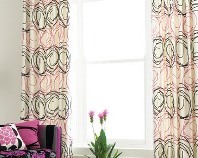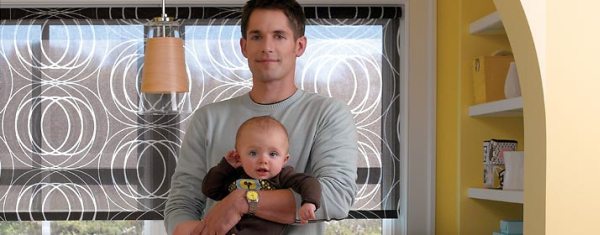How Can I Channel Crafting Into Decor for My House?
 December 28, 2009
December 28, 2009  Decoupage anything -- even your kitchen cabinets!
Decoupage anything -- even your kitchen cabinets!
Question
I'm 25 and love to tackle craft projects, but my boyfriend suggested that I turn some attention to decorating my very plain apartment. Any suggestions for how I can add stylish touches to my place using do-it-yourself energy and some crafting projects? (Stephanie from Queens, NY)
Answer
Thanks for your question, Stephanie. As we enter a new decade, everyone we talk to is eager to make some kind of positive decorating resolutions. We just received some great how-to decoupage suggestions from the decoupage experts at Full Circle Studio and thought we'd share their suggestions for creating lovely handmade home decor. (Of course those who aren't crafters and do-it-yourselfers should definitely go to the Full Circle Studio online store to purchase some great items to dress up any room.)
For more than a decade, Full Circle Studio has produced handcrafted embellishments for the home using classic decoupage design techniques. The company’s current collection includes more than 350 different collages, stylishly applied to switchplates, paperweights, coasters, and plaques. Full Circle Studio's collages are all original and handmade by Kate Hartley DiSantis and it's her belief that a small something we use every day, such as a light switch or a coaster, should reflect a person's individual style and bring joy to the home.
So, Stephanie, we'd like you to consider applying decoupage to some of your everyday items and surfaces at home. What can you decoupage? How about some unfinished furniture, like a small end table, coffee table, or desk? You might want to try it small at first, like a switchplate. These handmade decorative decoupage touches will fill your blah rooms with color and personality and put your crafting energy to good use.
But What Exactly Is Decoupage?
Although there is a renaissance going on within the world of decoupage and handmade crafts are on the rise, very few people know the history behind this centuries-old design technique. A seasoned decoupage expert, Kate shows you just how easy it is to bring personalized flair into your home, or pass unique inspirations along as the perfect gift for special occasions. Derived from the French word découper, which means “to cut up,” decoupage is the art of decorating objects using paper cutouts, paint effects, decorative details, and layers of lacquer and varnish.
Derived from the French word découper, which means “to cut up,” decoupage is the art of decorating objects using paper cutouts, paint effects, decorative details, and layers of lacquer and varnish.
From small household items like trinket boxes and vases to large pieces of furniture, decoupage is a fun and easy way to embellish just about any object.
Due to the multiple coats of varnish and meticulous sanding, finished products are so stunning that most think they're professionally painted.
The origins of the craft of decoupage can be traced back hundreds of years to several folk cultures, most notably in China, Japan, and Poland. However, decoupage reached its pinnacle in 18th century Europe when preprinted designs were sold commercially for customers to use on furniture and other household items. Some elite decoupage artists even achieved fame as designers in their own right. Over the centuries decoupage boasted many famous practitioners, including Marie Antoinette, Madame de Pompadour, Lord Byron, Beau Brummel and more recently, Matisse and Picasso. By the 1960s, decoupage had made its way across the Atlantic and everyday Americans were starting to decoupage ordinary household items into beautiful works of art. Today, there's a renaissance going on within the world of decoupage, and this centuries-old technique is experiencing a stimulating revival throughout the world.
So Let's Decoupage!
 The decoupage process can be learned fairly quickly and the possibilities are endless. Common household materials can be used to create exquisite works of art and if you know how to cut and paste, you already have the skills necessary to decoupage. These simple instructions will allow even the most novice of beginning crafters to embellish their favorite household items with ease.
The decoupage process can be learned fairly quickly and the possibilities are endless. Common household materials can be used to create exquisite works of art and if you know how to cut and paste, you already have the skills necessary to decoupage. These simple instructions will allow even the most novice of beginning crafters to embellish their favorite household items with ease.
The Supplies:
- Something to decoupage—coasters, picture frames, mirrors, and other household objects are all great options
- Paper embellishments—These can come from a variety of sources, including: magazines, newspapers, catalogs, books, printed clip art, wrapping paper, greeting cards, fabric, tissue paper, lace, etc.
- Scissors or Exacto knife
- Glue—White glue diluted with water works best for the initial pasting
- Smoother—Popsicle sticks or a craft bone can be found in most homes; many professionals use what is called a brayer, which resembles a miniature rolling pin and is designed to remove wrinkles, excess glue, and to even out pictures
- Glue spreader—best at-home tools include cotton swaps, paint brushes, and sponges
- Extra rags and sponges to help with clean up
- Sealer—Glue can be used as a medium, but you can also opt for polyurethane, spray acrylic, or other lacquers (all available at craft stores)
- Prepare the surface of your project by cleaning and drying it completely before beginning
- Cut out your pictures (or chosen embellishments)
- Arrange the pictures on your item—don’t be afraid of overlap
- Coat the back of the picture completely, using glue or other decoupage medium. Put a thin layer of glue in the area where you are placing the picture.
- Place the picture on the glue—don’t be afraid to get a little messy!
- Use your finger to gently push the picture down (for a large picture, start from the center and work your way out) and push out any wrinkles and excess glue. You can also use a Popsicle stick, crafting bone, or brayer.
- Continue with the last 2 steps until all your pictures are glued on. Let the glue dry. (Note: It's very important to allow the glue to dry completely, otherwise your pictures may warp.)
- Coat your item completely with diluted white glue (approximately three parts glue to one part water) or other decoupage medium. Let this dry completely.
- Continue to add coats of the glue or another sealer (polyurethane, acrylic spray, etc.) until the edges of the pictures are smooth.
Voila! Creating a fun and personal piece of artwork for your home has never been so simple and fun. Happy crafting!
Thanks to Kate Hartley DiSantis and Full Circle Studio for this great how-to information and DIY decorating inspiration.
 Full Circle Studio,
Full Circle Studio,  crafts,
crafts,  decorating,
decorating,  decoupage,
decoupage,  how-to in
how-to in  Do It Yourself,
Do It Yourself,  interior design
interior design 






















